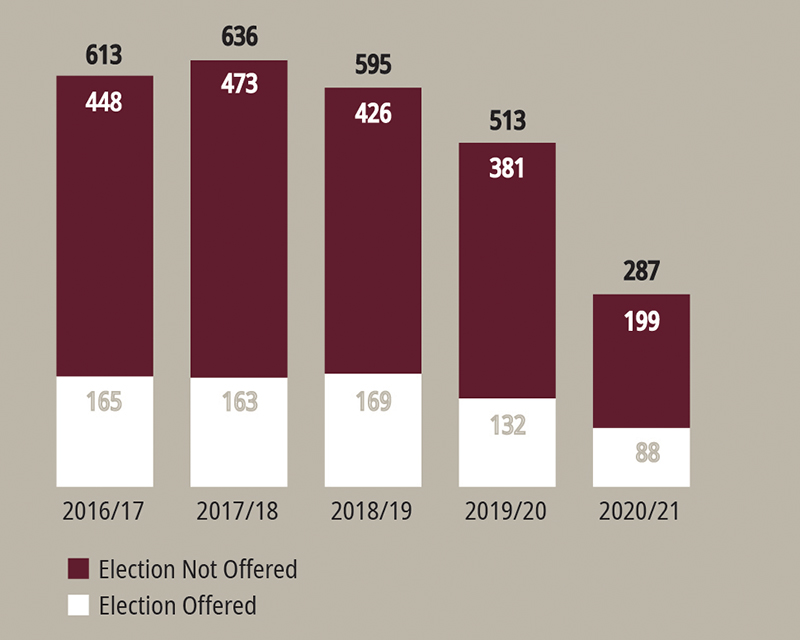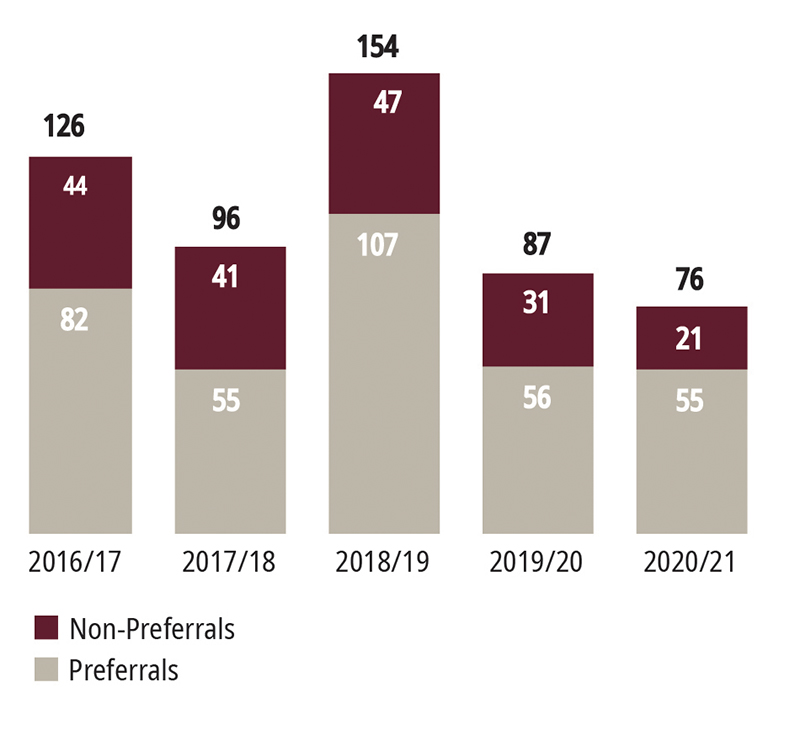Chapter Two — The Canadian Military Justice System: Structure and Statistics
Canada’s Military Justice System
Canada’s military justice system is a separate and parallel system of justice that forms an integral part of the Canadian legal mosaic. It shares many of the same underlying principles as the civilian criminal justice system, and it is subject to the same constitutional framework, including the Canadian Charter of Rights and Freedoms.Footnote 1 On several occasions, the Supreme Court of Canada has considered the requirement for a separate and distinct military justice system to meet the specific needs of the Canadian Armed ForcesFootnote 2 and has recently recognized the military justice system as a “full partner in administering justice alongside the civilian justice system.”Footnote 3
The military justice system is designed to promote the operational effectiveness of the Canadian Armed Forces by contributing to the maintenance of discipline, efficiency, and morale, while ensuring that justice is administered fairly and with respect to the rule of law. These objectives give rise to many of the substantive and procedural differences that distinguish the military justice system from the civilian justice system.
In R v Stillman, 2019 SCC 40 (at para 20) the Supreme Court of Canada recognized that the military justice system is a “full partner in administering justice alongside the civilian justice system.”
The Structure of the Military Justice System
The Code of Service Discipline
As noted by the Supreme Court of Canada, the Code of Service Discipline, which is contained in Part III of the National Defence Act,Footnote 4 is “[t]he foundation of Canada’s military justice system.”Footnote 5 The Code of Service Discipline has been recognized as “an essential ingredient of service life”Footnote 6 that “defines the standard of conduct to which military personnel and certain civilians are subject and provides for a set of military tribunals to discipline breaches of that standard.”Footnote 7 While the Code of Service Discipline is “primarily concerned with maintaining discipline and integrity in the Canadian Armed Forces,”Footnote 8 it “serves a public function as well by punishing specific conduct which threatens public order and welfare.”Footnote 9 It also sets out the procedures and organization of service tribunals, the jurisdiction of various actors in the military justice system, the powers of punishment, and the post-trial review and appeal mechanisms.
The term “service offence” is defined in the National Defence Act as “an offence under this Act, the Criminal Code, or any other Act of Parliament, committed by a person while subject to the Code of Service Discipline.”Footnote 10 Thus, service offences include many disciplinary offences that are unique to the profession of arms, such as disobedience of a lawful command,Footnote 11 absence without leave,Footnote 12 and conduct to the prejudice of good order and discipline,Footnote 13 as well as more conventional offences such as those found in the Criminal CodeFootnote 14 and other Acts of Parliament. Members of the Regular Force of the Canadian Armed Forces are subject to the Code of Service Discipline everywhere and at all times, whereas members of the Reserve Force and other categories of persons are subject to the Code of Service Discipline only in the circumstances specified by section 60 of the National Defence Act.
“The military justice system is therefore designed to meet the unique needs of the military with respect to discipline, efficiency, and morale … [T]o maintain the Armed Forces in a state of readiness, the military must be in a position to enforce internal discipline effectively and efficiently.” R v Stillman, 2019 SCC 40 (at para 36).
The Two Tiers of the Military Justice System
The military justice system currently has a tiered tribunal structure comprised of two types of service tribunals: summary trials and courts martial. The Queen’s Regulations and Orders for the Canadian ForcesFootnote 15 outline procedures for the disposal of a charge by each type of service tribunal.
The following sections describe the two tiers of the military justice system as they currently exist; however, with the implementation of An Act to amend the National Defence Act and to make related and consequential amendments to other Acts,Footnote 16 the summary trial process will be transformed into a non-penal, non-criminal summary hearing process designed to address minor breaches of military discipline at the unit level. With this reform, courts martial alone will have jurisdiction over service offences. A more detailed description of the work undertaken during the reporting period to implement these changes can be found in Chapter 3 under the heading Legislative Developments.
Summary Trials
The summary trial is the most commonly used form of service tribunal. It allows for relatively minor service offences to be tried and disposed of quickly and fairly at the unit level. Summary trials are presided over by commanding officers or other specified classes of officers, who are trained and certified by the Judge Advocate General as qualified to perform their duties as presiding officers in the administration of the Code of Service Discipline.Footnote 17 All accused members are entitled to be assigned an assisting officer who will aid the accused member in the preparation of their case, during the summary trial,Footnote 18 and in the preparation of any post-trial request for review. Footnote 19 At summary trial, the procedures are staightforward and the powers of punishment are limited in scope,Footnote 20 which is reflective of the relatively minor nature of the offences involved and the intent that the punishments be primarily corrective in nature.
The jurisdiction at summary trial is limited by factors such as the rank of the accused and the offence or offences charged. All service offences may be tried by court martial, and while some offences must be tried by court martial, those listed in article 108.07 of the Queen’s Regulations and Orders for the Canadian Forces may also be tried by summary trial. Military judgesFootnote 21 and other officers at or above the rank of Colonel,Footnote 22 however, cannot be tried by summary trial.
For the majority of offences that can be dealt with by summary trial, the accused member will have the right to elect a trial by court martial.Footnote 23 The election process has been designed to provide the accused member with the opportunity to make an informed choice regarding the type of service tribunal that will try the matter.
It is required that charges laid under the Code of Service Discipline be dealt with as expeditiously as the circumstances permit.Footnote 24 Unless the accused member waives the limitation periods, they may not be tried by summary trial unless the charge is laid within six months after the day on which the service offence is alleged to have been committed, and the summary trial commences within one year after that day.Footnote 25
Summary Trials
- Most commonly used form of service tribunal
- Designed to quickly and fairly try minor service offences at the unit level
- Presided over by members of the chain of command
- Accused persons are entitled to an assisting officer throughout the process
- Except in certain circumstances, accused persons have the right to elect to be tried by court martial or summary trial
- A person found guilty at summary trial has the right to apply for a review of the finding, the sentence imposed, or both
Review of a Finding Made and/or Sentence Imposed at Summary Trial
A member of the Canadian Armed Forces found guilty of a service offence at summary trial has the right to request that a review authority review the finding rendered, the punishment imposed, or both.Footnote 26 A review authority may also, on their own initiative, undertake a review of the finding and/or punishment.Footnote 27 As provided for under articles 108.45 and 116.02 of the Queen’s Regulations and Orders for the Canadian Forces, a review authority is typically a more senior officer in the chain of command of the officer who presided over the summary trial. A review authority has the power to quash any finding of guilty; substitute a new finding for any finding of guilty; alter any sentence; and mitigate, commute or remit any punishment imposed at summary trial.Footnote 28 Before making any determination, a review authority must first obtain legal advice.Footnote 29
Bill C-77 will transform the summary trial process into a non-penal, non-criminal summary hearing process, limited in jurisdiction to service infractions to be created by regulations, and designed to address minor breaches of military discipline.
Courts Martial
The court martial is a formal military court presided over by a military judge. It is designed to deal with more serious offences and has powers of punishment up to and including imprisonment for life. Courts martial are conducted in accordance with rules and procedures similar to those of civilian criminal courts, while taking into account the unique requirements of the military justice system. Courts martial exercise the same rights, powers and privileges as a superior court of criminal jurisdiction with respect to all “matters necessary or proper for the due exercise of [their] jurisdiction.”Footnote 30
Courts martial, like summary trials, can be convened anywhere in Canada and abroad. The National Defence Act provides for two types of courts martial: General and Standing. The General Court Martial is composed of a military judge and a panel of five Canadian Armed Forces members. The panel serves as the trier of fact and decides on any finding of guilt. In the event of a guilty finding, it is the military judge who determines the sentence or directs that the offender be discharged absolutely. At a Standing Court Martial, the military judge sits alone, makes any required findings and, if the accused person is found guilty, imposes the sentence or directs that the individual be discharged absolutely.
At court martial, the prosecution is conducted by a military prosecutor under the authority of the Director of Military Prosecutions. The accused is entitled to be represented by defence counsel assigned by the Director of Defence Counsel Services at no cost, or by civilian counsel at their own expense.Footnote 31
Appeal of a Court Martial Decision
Decisions made at court martial may be appealed to the Court Martial Appeal Court of Canada by the person subject to the Code of Service Discipline or by the Minister of National Defence or counsel instructed by the Minister.Footnote 32 The Court Martial Appeal Court of Canada is composed of civilian judges who are appointed by the Governor in Council from the Federal Court of Appeal, the Federal Court, or from the superior courts and courts of appeal of the provinces and territories.
Court Martial Appeal Court of Canada decisions may be appealed to the Supreme Court of Canada on any question of law on which a judge of the Court Martial Appeal Court of Canada dissents, or on any question of law when leave to appeal is granted by the Supreme Court of Canada.
Courts Martial
- Formal proceedings presided over by a military judge. Military judges are appointed by the Governor in Council, similarly to their civilian counterparts
- Designed to deal with more serious offences
- There are two types of court martial: 1) Standing Court Martial presided over by a military judge alone; and 2) General Court Martial presided over by a military judge and a panel composed of five Canadian Armed Forces members, who serve as the triers of fact and decide unanimously on any finding
- For both Standing and General courts martial, the military judge determines the sentence
- Accused persons have the right to be represented by counsel from Defence Counsel Services at no cost, or by civilian counsel at their own expense. In some cases, civilian counsel can be provided at no cost by Defence Counsel Services
- A person subject to the Code of Service Discipline has the right to appeal from court martial to the Court Martial Appeal Court in relation to a number of matters including the legality of any finding of guilty and the legality of the the whole of any part of the imposed sentence
Statistics
The statistics provided in this chapter reflect the quantitative data collected on the military justice system over the 2020/21 reporting period. This reporting period marks the first full reporting period affected by the COVID-19 pandemic.
In response to the COVID-19 pandemic, the Department of National Defence and the Canadian Armed Forces took unprecedented measures to protect the health and well-being of its members, prevent the spread of the virus, and continue essential military operations including contributing to the national response to the pandemic in support of civilian authorities. Although the military justice system adapted quickly to the circumstances to meet the disciplinary needs of the Canadian Armed Forces, the reporting period saw a dramatic decrease in the number of trials held with a 44% reduction in the number of completed summary trials and a 38% reduction in the number of completed courts martial. While it is not possible to identify an exact cause for this decrease, certain measures taken by the Canadian Armed Forces in the face of the pandemic, including activating business continuity plans that limited the number of personnel in the workplace and working together, restricting gatherings and closing social gathering places such as messes, halting the parading of reserve units, as well as transitioning from in-person to online training, may have influenced the number of offences charged and the number of service tribunals held during the reporting period.
Summary Trials
Number of Summary Trials
During this reporting period, there were 287 summary trials and 34 courts martial conducted. Summary trials made up approximately 89% of trials held before service tribunals. Summary trials continued to be the most widely used form of service tribunal in the Canadian Armed Forces.
Figure 2-1 shows the number of summary trials and courts martial held over the last two reporting periods as well as the corresponding percentage of cases tried by each type of service tribunal. Figure 2-2 shows the total number of summary trials by reporting period since 2016/17.
Figure 2-1: Distribution of Service Tribunals
| 2019-2020Footnote 33 | 2020-2021 | |||
|---|---|---|---|---|
| # | % | # | % | |
| Number of Courts Martial | 55 | 9.68 | 34 | 10.60 |
| Number of Summary Trials | 513 | 90.32 | 287 | 89.40 |
| Total | 568 | 100 | 321 | 100 |
Figure 2-2: Graph breakdown
| 2016/17 | 2017/18 | 2018/19 | 2019/20 | 2020/21 | |
|---|---|---|---|---|---|
| Number of Summary Trials | 613 | 636 | 595 | 513 | 287 |
Figure 2-3 shows the total number of summary trials held over the last two reporting periods by organization. Figure 2-4 specifically illustrates the number of summary trials held since the 2016/17 reporting period within the following five commands: the Canadian Army, the Royal Canadian Navy, the Royal Canadian Air Force, Military Personnel Command, and the Canadian Joint Operations Command.
Figure 2-3: Number of Summary Trials by Organizations
| 2019-2020 | 2020-2021 | |||
|---|---|---|---|---|
| # | % | # | % | |
| Canadian Army | 230 | 44.84 | 129 | 44.94 |
| Royal Canadian Navy | 98 | 19.10 | 52 | 18.12 |
| Chief of Military Personnel | 56 | 10.92 | 19 | 6.62 |
| Royal Canadian Air Force | 65 | 12.67 | 44 | 15.33 |
| Canada Joint Operations Command | 44 | 8.58 | 28 |
9.76 |
| Canada Special Operations Forces Command | 7 | 1.36 |
7 | 2.44 |
| Vice Chief of the Defence Staff | 10 | 1.95 | 4 | 1.39 |
| Assistant Deputy Minister (Material) | 1 | 0.19 | 0 | 0.00 |
| Assistant Deputy Minister (Information Management) | 2 | 0.39 | 1 | 0.35 |
| Assistance Deputy Minister (Infrastructure and Environment Branch) | 0 | 0.00 | 2 | 0.70 |
| Canadian Forces Intelligence Command |
0 | 0.00 | 1 | 0.35 |
| Total | 513 | 100 | 287 | 100 |
Figure 2-4: Number of Summary Trials for the Canadian Army, the Royal Canadian Navy, the Royal Canadian Air Force, the Military Personnel Command, and the Canadian Joint Operations Command
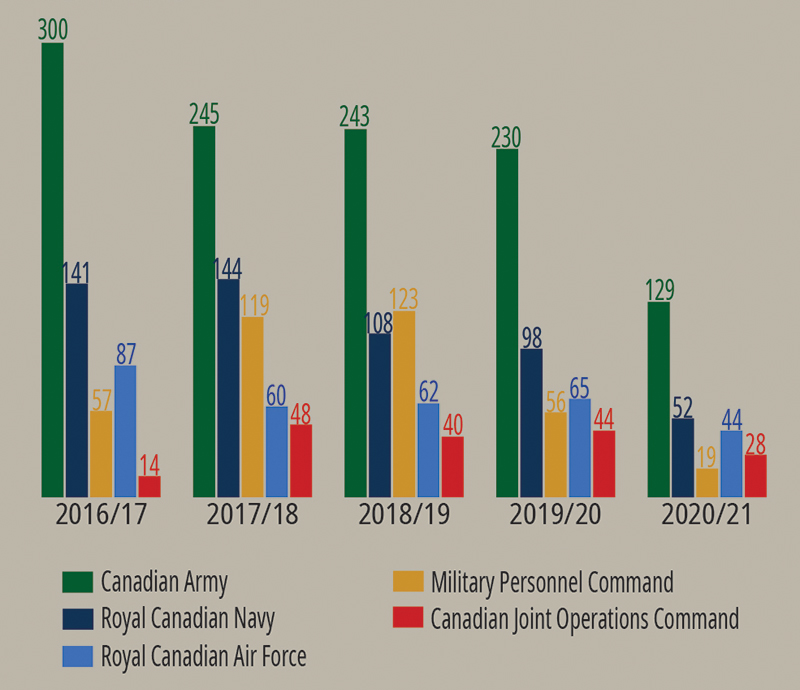
Figure 2-4: Graph breakdown
| 2016/17 | 2017/18 | 2018/19 | 2019/20 | 2020/21 | |
|---|---|---|---|---|---|
| Canadian Army | 300 | 245 | 243 | 230 | 129 |
| Royal Canadian Navy | 141 | 144 | 108 | 98 | 52 |
| Chief of Military Personnel | 57 | 119 | 123 | 56 | 19 |
| Royal Canadian Air Force | 87 | 60 | 62 | 65 | 44 |
| Canada Joint Operations Command | 14 | 48 | 40 | 44 | 28 |
In this reporting period, the Canadian Army held a total of 129 summary trials as compared to 230 in the previous reporting period. This is a decrease of 102 summary trials, or approximately 44% from the 2019/20 reporting period. Since 2016/17 the number of summary trials held within the Canadian Army has decreased each year.
Since 2017/18, the Royal Canadian Navy has seen a steady decrease in summary trials. During this reporting period, there were a total of 52 summary trials, as compared to 98 in the previous reporting period. This is a decrease of approximately 47%.
The Royal Canadian Air Force conducted 44 summary trials in this reporting period, which is a decrease of 32% from the 65 held during the last reporting period. Summary trials in the Royal Canadian Air Force have been generally trending downward since 2016/17, when 87 summary trials were held.
In this reporting period, 19 summary trials were conducted within the Military Personnel Command, compared to 56 in the previous reporting period. This represents approximately 66% fewer summary trials than the previous reporting period. Percentage-wise, this decrease is consistent with numbers observed during the last reporting period, when summary trials decreased from 123 to 56.
Finally, the Canadian Joint Operations Command held
28 summary trials in comparison to 44 in the previous reporting period. This represents a decrease of approxi-mately 36%. Since 2016-17, the Canadian Joint Oper-ations Command summary trial numbers have varied, displaying no significant pattern of increase or decrease.
Number of Charges Disposed of at Summary TrialFootnote 34
In this reporting period, there were a total of 418 charges disposed of at summary trial compared to 726 during the 2019/20 reporting period. Figure 2-5 shows the total number of charges disposed of at summary trial since 2016/17, and demonstrates a consistent decrease.
Figure 2-5: Number of Charges Disposed of at Summary Trial

Figure 2-5: Graph breakdown
| 2016/17 | 2017/18 | 2018/19 | 2019/20 | 2020/21 | |
|---|---|---|---|---|---|
| Number of Charges Disposed of at Summary Trial | 911 | 853 | 838 | 726 | 418 |
The most commonly charged service offences, which account for approximately 70% of all charges disposed of at summary trial, are under section 90 of the National Defence Act, absence without leave, and under section 129, conduct to the prejudice of good order and discipline.Footnote 35
Since the 2016/17 reporting period, there has been a consistent decrease in the total number of charges reported for absence without leave. In the current reporting period the total number was 130, compared to 269 in the 2019/20 reporting period. Although the quantitative decrease appears significant, proportionally the number of charges for absence without leave was 31%, and saw only a 6% decrease as compared to 37% in the previous reporting period.
In this reporting period, there were a total of 162 charges for the offence of conduct to the prejudice of good order and discipline. Although this reporting period saw a significant decrease in the number of charges from the 253 charges reported in the 2019/20 reporting period, the proportional number of charges for conduct to the prejudice of good order and discipline increased slightly from 35% in the previous reporting to 39%. Figure 2-6 shows the number of charges for absence without leave and conduct to the prejudice of good order and discipline between 2016/17 and 2020/21.
Figure 2-6: Number of Charges for Conduct to the Prejudice of Good Order and Discipline and Absence without Leave
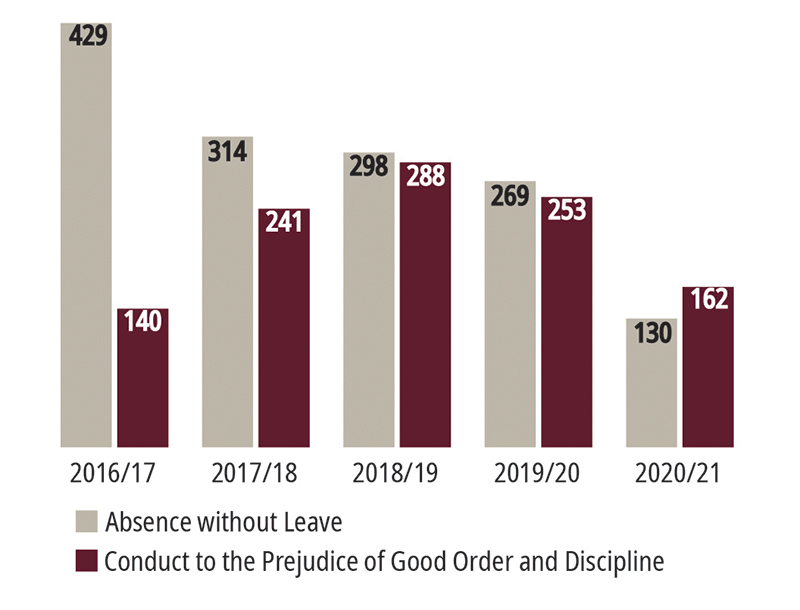
Figure 2-6: Graph breakdown
| 2016/17 | 2017/18 | 2018/19 | 2019/20 | 2020/21 | |
|---|---|---|---|---|---|
| Absence without Leave | 429 | 314 | 298 | 269 | 130 |
| Conduct to the Prejudice of Good Order and Discipline | 140 | 241 | 288 | 253 | 162 |
Number of Elections to be Tried by Court Martial
Pursuant to article 108.17 of the Queen’s Regulations and Orders for the Canadian Forces, an accused person will be offered an election to be tried by court martial, unless the following two criteria are met:
- each offence with which the individual has been charged is one of the following: insubordination, drunkenness, absence without leave, quarrels and disturbances, and conduct to the prejudice of good order and discipline (where the offence relates to military training, maintenance of personal equipment, quarters or work space, or dress and deportment); and
- the circumstances surrounding the commission of the offences are so minor in nature that the presiding officer concludes that a punishment of detention, reduction in rank, or a fine in excess of 25 percent of monthly basic pay would not be warranted if the accused person were found guilty.
During this reporting period, a total of 112 elections to be tried by court martial were offered to accused persons. Out of the 112 elections offered, 88 accused persons elected to be tried by summary trial, which represents 79% of the total elections offered. The remaining 24 accused persons elected to be tried by court martial, which represents 21% of the total elections offered. The percentage of accused persons electing to be tried by court martial has increased by 22% from the 2019/20 reporting period.
Figure 2-7 represents the percentage of accused members who elected to be tried by court martial over the past five reporting periods.
Figure 2-8 shows the number of summary trials completed over the past five reporting periods where the accused person was offered an election to be tried by court martial, as well as the number of summary trials completed where no election was offered.
Figure 2-9 shows the percentage of summary trials completed over the past five reporting periods where the accused person elected to be tried by summary trial.
Figure 2-7: Percentage of Accused Electing to be Tried by Court Martial

Figure 2-7: Graph breakdown
| 2016/17 | 2017/18 | 2018/19 | 2019/20 | 2020/21 | |
|---|---|---|---|---|---|
| Percentage of Accused Electing to be Tried by Court Martial | 24.09 | 22.33 | 23.21 | 18.18 | 21.43 |
Figure 2-8: Graph breakdown
| 2016/17 | 2017/18 | 2018/19 | 2019/20 | 2020/21 | |
|---|---|---|---|---|---|
| Election Not Offered | 448 | 473 | 426 | 381 | 199 |
| Election Offered | 165 | 163 | 169 | 132 | 88 |
| Total | 613 | 636 | 595 | 513 | 287 |
Figure 2-9: Number of Summary Trials Completed where Accused Offered an Election, expressed as a Percentage

Figure 2-9: Graph breakdown
| 2016/17 | 2017/18 | 2018/19 | 2019/20 | 2020/21 | |
|---|---|---|---|---|---|
| Number of Summary Trials Completed where Accused Offered an Election, expressed as a Percentage | 26.92 | 25.63 | 28.40 | 25.73 | 30.66 |
Waiver of Limitation Periods
Pursuant to article 108.16(1.1) of the Queen’s Regulations and Orders for the Canadian Forces, a charge must be laid against an accused person within six months from the date the service offence is alleged to have been committed, and the summary trial must commence within one year of that date. Pursuant to article 108.171 of the Queen’s Regulations and Orders for the Canadian Forces, an accused person has the right to waive one or both of these limitation periods.Footnote 37
In this reporting period, there were 46 waivers offered to accused persons, an increase of four from the 2019/20 reporting period. Of the 46 waivers offered, the accused person chose to waive one or both of the limitation periods in 37 cases.
Results by Charge at Summary Trial
The findings at summary trial, by charge, have remained relatively consistent over the last five reporting periods. This reporting period saw a decrease in the percentage of guilty findings, from approximately 91% in the 2019/20 reporting period, to approximately 88% in this reporting period. Although the number of not guilty findings has decreased from 42 to 35, not guilty findings made up approximately 8% of findings in this reporting period as opposed to approximately 6% in the previous reporting period. A complete breakdown of the total number of findings by charge and the corresponding percentages for the last two reporting periods can be found at Figure 2-10.
Figure 2-10: Findings by Charge
| 2019-2020 | 2020-2021 | |||
|---|---|---|---|---|
| # | % | # | % | |
| Guilty | 658 | 90.65 | 367 | 87.80 |
| Guilty – Special Finding | 3 | 0.41 | 2 | 0.48 |
| Not guilty | 42 | 5.77 | 35 | 8.37 |
| Charge stayed | 17 | 2.34 | 5 | 1.20 |
| Charge not proceeded with | 6 | 0.83 | 9 | 2.15 |
| Total | 726 | 100 | 418 | 100 |
Punishments and Absolute Discharges at Summary Trial
In this reporting period, there were a total of 356 punishments and absolute discharges imposed at summary trial.Footnote 38 Fines and confinement to ship or barracks continued to be the most commonly imposed punishments. Figure 2-11 shows the number of absolute discharges and punishments by type that were imposed at summary trial for the last two reporting periods as well as the corresponding percentages.
Figure 2-11: Punishments and Absolute Discharges at Summary Trial
| 2019-2020 | 2020-2021 | |||
|---|---|---|---|---|
| # | % | # | % | |
| Detention | 3* | 0.47 | 2 | 0.56 |
| Reduction in rank | 3 | 0.47 | 2 | 0.56 |
| Severe reprimand | 2 | 0.31 | 3 | 0.84 |
| Reprimand | 24 | 3.72 | 22 | 6.18 |
| Fine | 401 | 62.16 | 237 | 66.58 |
| Confinement to ship or barracks | 147 | 22.79 | 46 | 12.92 |
| Extra work and drill | 56 | 8.68 | 33 | 9.27 |
| Stoppage of leave | 6 | 0.93 | 7 | 1.97 |
| Absolute DischargeFootnote 39 | 3 | 0.47 | 4 | 1.12 |
| Total | 645 | 100 | 356 | 100 |
| * Includes one punishment which was a Suspended Detention |
||||
In this reporting period, the punishment of detention was imposed twice. This number is consistent with the previous reporting period, where three punishments of detention were imposed, and one was suspended. An overview of the number of punishments of detention imposed at summary trial over the last five reporting periods can be found in Figure 2-12.
Figure 2-12: Total Punishments of Detention

Figure 2-12: Graph breakdown
| 2016/17 | 2017/18 | 2018/19 | 2019/20 | 2020/21 | |
|---|---|---|---|---|---|
| Total Punishments of Detention | 10 | 10 | 11 | 3 | 2 |
Summary Trial Reviews
In the current reporting period, a total of 24 summary trials were reviewed pursuant to articles 108.45 (requests by members found guilty at summary trial) and 116.02 (on the review authority’s own initiative) of the Queen’s Regulations and Orders for the Canadian Forces. This represents approximately 8% of the 287 summary trials conducted in this reporting period. The number also represents a relative increase of approximately 33% of cases reviewed compared to the 6% reported in the 2019/20 reporting period. Of the reviews, eight were based on findings, seven were based on punishment, and nine were based on both findings and punishment. Figure 2-13 shows the percentage of cases for which a review has been conducted since 2016/17.
Figure 2-13: Percentage of Summary Trials Reviewed
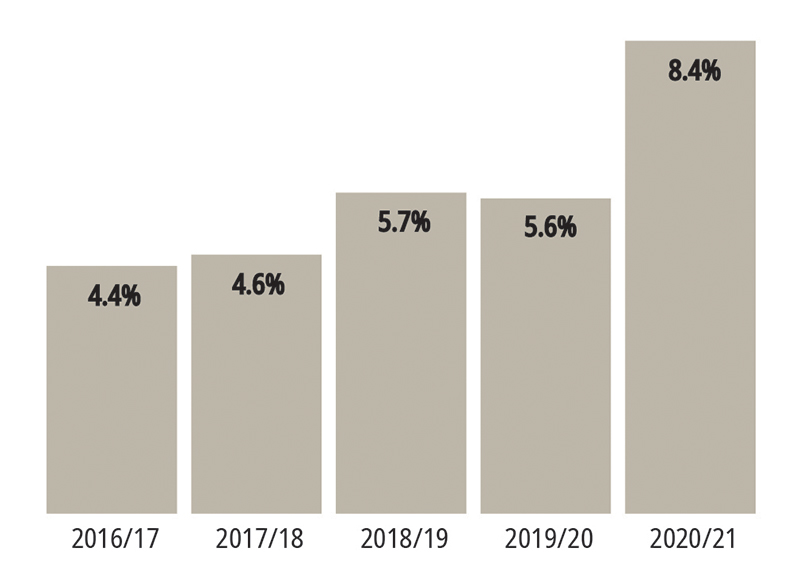
Figure 2-13: Graph breakdown
| 2016/17 | 2017/18 | 2018/19 | 2019/20 | 2020/21 | |
|---|---|---|---|---|---|
| Percentage of Summary Trials Reviewed | 4.4 | 4.6 | 5.7 | 5.6 | 8.4 |
In relation to a review, a review authority can render one of the following decisions: to uphold the presiding officer’s decision; to quash a guilty finding; or to substitute a finding or punishment. In this reporting period, review authorities quashed 50% of the findings of guilty for which a review was undertaken. Additionally, review authorities upheld 33% of the decisions of presiding officers. A complete breakdown of all decisions of review authorities for the past two reporting periods can be found at Figure 2-14.
Figure 2-14: Decisions of Review Authority
| 2019-2020 | 2020-2021 | |||
|---|---|---|---|---|
| # | % | # | % | |
| Upholds decision | 9 | 26.47 | 8 | 33.33 |
| Quashes findings | 15 | 44.12 | 12 | 50 |
| Substitutes findings | 1 | 2.94 | 0 | 0 |
| Substitutes punishment | 3 | 8.82 | 1 | 4.17 |
| Mitigates / commutes / remits punishment | 6 | 17.65 | 3 | 12.50 |
| Total | 34 | 100 | 24 | 100 |
Harmful and Inappropriate Sexual Behaviour and Sexual Misconduct
At the summary trial level, charges of harmful and inappropriate sexual behaviour and sexual misconduct that do not meet the threshold of sexual assault, are most frequently charged under section 129 of the National Defence Act, conduct to the prejudice of good order and discipline. This includes but is not limited to behaviours such as sexual harassment, verbal and/or physical harassment, and sharing and displaying inappropriate materials such as videos or photos of a sexual nature.
In the current reporting period, there were a total of 20 charges for the offence of conduct to the prejudice of good order and discipline in relation to harmful and inappropriate sexual behaviour and sexual misconduct, compared to 33 charges in the previous reporting period. Of these 20 charges, 19 resulted in a guilty finding and one in a finding of not guilty. Furthermore, of these 20 charges, 12 were related to verbal comments of a sexual nature, four related to physical acts of a sexual nature, three related to displaying materials of a sexual nature, and in one case the nature of the alleged behaviour was not specified in the Record of Disciplinary Proceedings.
Language of Summary Trials
Pursuant to article 108.16 of the Queen’s Regulations and Orders for the Canadian Forces, accused persons have the right to be tried in the official language of their choice. The presiding officer must be able to understand the language in which the proceedings are to be conducted without the assistance of an interpreter.
In this reporting period, 77% of summary trials were conducted in English and 23% were conducted in French. These numbers are consistent with the previous reporting period. Figure 2-15 shows the total number of summary trials conducted in both English and French for the past two reporting periods.
Figure 2-15: Language of Summary Trials
| 2019-2020 | 2020-2021 | |||
|---|---|---|---|---|
| # | % | # | % | |
| Number in English | 394 | 76.80 | 221 | 77.00 |
| Number in French | 119 | 23.20 | 66 | 23.00 |
| Total | 513 | 100 | 287 | 100 |
Timelines for Summary Trials
The purpose of the summary trial system is to provide prompt and fair justice in respect of minor service offences. As such, these trials are required to begin within one year of the date on which the offence is alleged to have occurred, unless this limitation period is waived by the accused person.Footnote 40
This reporting period saw 287 summary trials completed, and the average time from the alleged offence to the conclusion of the summary trial was approximately 127 days. Of these 287 summary trials, 145 concluded within 90 days of the alleged offence, representing approximately 51% of all summary trials for the reporting period. Further, approximately 75% of summary trials were concluded within 180 days of the alleged offence. Figure 2-16 shows a breakdown of the number of days from the alleged offence to the conclusion of the summary trial.
Figure 2-16: Number of Days from Alleged Offence to the Conclusion of the Summary Trial for Reporting Period 2020/21Footnote 41
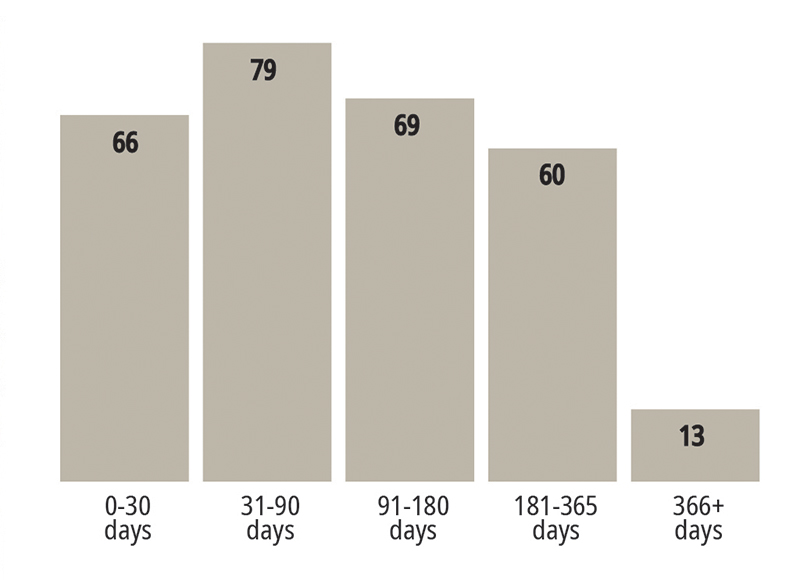
Figure 2-16: Graph breakdown
| 0-30 days | 31-90 days | 91-180 days | 181-365 days | 366 days or more | |
|---|---|---|---|---|---|
| Number of Days from Alleged Offence to the Conclusion of the Summary Trial for Reporting Period 2020/21 | 66 | 79 | 69 | 60 | 13 |
Once a charge is laid by the appropriate authority and is referred to a presiding officer, the presiding officer may be required to obtain legal advice before commencing the summary trial.Footnote 42 Once legal advice has been received from the unit legal advisor, the presiding officer may commence the summary trial.
Over the past five reporting periods, the average time between the laying of a charge to the conclusion of the summary trial has fluctuated, reaching a low of 15 days in the 2017/18 reporting period. This number increased during the current reporting period to approximately 35 days. Figure 2-17 shows the average time from charge laid to the conclusion of the summary trial over the last five reporting periods.
At this time, reporting capabilities do not provide data on the length of summary trials from start to finish, however, with the ongoing development and rollout of the Justice Administration and Information Management System, this data will be available to the Office of the JAG in future reporting periods.
Figure 2-17: Average Number of Days from Charge Laid to Summary Trial

Figure 2-17: Graph breakdown
| 2016/17 | 2017/18 | 2018/19 | 2019/20 | 2020/21 | |
|---|---|---|---|---|---|
| Average Number of Days from Charge Laid to Summary Trial |
20 | 15 | 24 | 25 | 35 |
Courts MartialFootnote 43
Number of Courts Martial
During this reporting period, there were a total of 34 courts martial, representing approximately 11% of all trials held before service tribunals. This is a decrease of 21 courts martial from the previous reporting period. Figure 2-18 demonstrates the number of courts martial by year since 2016/17.
Figure 2-18: Number of Courts Martial

Figure 2-18: Graph breakdown
| 2016/17 | 2017/18 | 2018/19 | 2019/20 | 2020/21 | |
|---|---|---|---|---|---|
| General Courts Martial | 4 | 5 | 6 | 10 | 7 |
| Standing Courts Martial | 52 | 57 | 45 | 45 | 27 |
| Total | 56 | 62 | 51 | 55 | 34 |
Results by Case at Court Martial
Of the 34 courts martial held during this reporting period, 25 cases resulted in a finding of guilty on at least one charge; seven casesFootnote 44 resulted in a stay of proceedings; one case resulted in a termination of proceedings; and one case resulted in all charges being withdrawn. Figure 2-19 shows the disposition by case over the past two reporting periods.
Figure 2-19: Disposition of Cases at Court Martial
| 2019-2020 | 2020-2021 | |||
|---|---|---|---|---|
| # | % | # | % | |
| Found Guilty of at Least One Charge | 44 | 80.00 | 25 | 73.53 |
| Not Guilty of All Charges | 7 | 12.73 | 0 | 0.00 |
| Stay of All Charges | 0 | 0.00 | 7 | 20.59 |
| Withdrawal of All Charges | 3 | 5.45 | 1 | 2.94 |
| Termination of Proceedings | 1 | 1.82 | 1 | 2.94 |
| Total | 55 | 100 | 34 | 100 |
Director of Military Prosecutions Case Management
Referrals
During this reporting period, the Director of Military Prosecutions received a total of 76 referrals for trial by court martial, remaining consistent with the 76 cases received in the previous reporting period. There were 47 cases carried over from the previous reporting period resulting in a total of 123 referrals processed in 2020/21. This represents a decrease of 5% when compared to the 130 referrals processed in the previous reporting period.
Figure 2-20 shows the number of referrals received by the Director of Military Prosecutions over the last five reporting periods and the number of referrals processed within each respective reporting period.
Figure 2-20: Number of Referrals
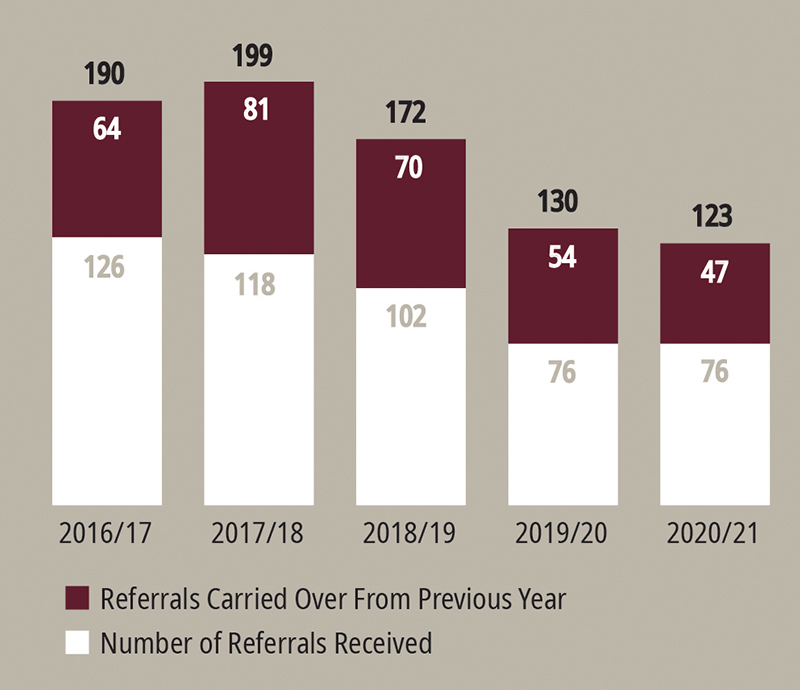
Figure 2-20: Graph breakdown
| 2016/17 | 2017/18 | 2018/19 | 2019/20 | 2020/21 | |
|---|---|---|---|---|---|
| Cases Carried Over From Previous Reporting Period | 64 | 81 | 70 | 54 | 47 |
| Number of Referrals Received During Current Reporting Period | 126 | 118 | 102 | 76 | 76 |
| Total | 190 | 199 | 172 | 130 | 123 |
Preferrals and Non-Preferrals
During this reporting period, 55 cases were preferred for trial by court martial and there were 21 cases in which no charges were preferred by the Director of Military Prosecutions. The percentage of cases preferred for trial by court martial in this reporting period was 72%. Although the number of cases preferred represents a slight decrease from the 2019/20 reporting period in which 56 cases were preferred, the percentage of preferrals has increased by 8%. This reporting period marks the highest rate of preferrals over the past five reporting periods. The lowest rate of preferrals was 57% in the 2017/18 reporting period.
Figure 2-21 illustrates the number of files preferred by the Director of Military Prosecutions and the number of files where no charges were preferred over the past five reporting periods.
Figure 2-21: Graph breakdown
| 2016/17 | 2017/18 | 2018/19 | 2019/20 | 2020/21 | |
|---|---|---|---|---|---|
| Non-Preferrals | 44 | 41 | 47 | 31 | 21 |
| Preferrals | 82 | 55 | 107 | 56 | 55 |
| Total | 126 | 96 | 154 | 87 | 76 |
Timelines
During this reporting period, the average time from the referral of a matter to the Director of Military Prosecutions to a post-charge decision was approximately 81 days.Footnote 46 This represents an increase of approximately 11 days, or 16% from the previous reporting period. Figure 2-22 illustrates the average time from referral to post-charge decision over the course of the past five reporting periods.
Figure 2-22: Number of Days from Referral of File to the Director of Military Prosecutions to Post-Charge Decision

Figure 2-22: Graph breakdown
| 2016/17 | 2017/18 | 2018/19 | 2019/20 | 2020/21 |
|---|---|---|---|---|
| 89 | 95 | 88 | 70 | 81 |
During this reporting period, the average length of time for the commencement of a court martial following the preferral of charges was approximately 232 days, a decrease of 46 days from the previous reporting period, or 17%. The average time from the preferral of a charge to the commencement of a court martial in the previous reporting period was 278 days. Figure 2-23 demonstrates the average length of time for a court martial to commence once charges against an accused person were preferred over the past five reporting periods.
Figure 2-23: Number of Days from Preferral of Charges to Beginning of Court Martial
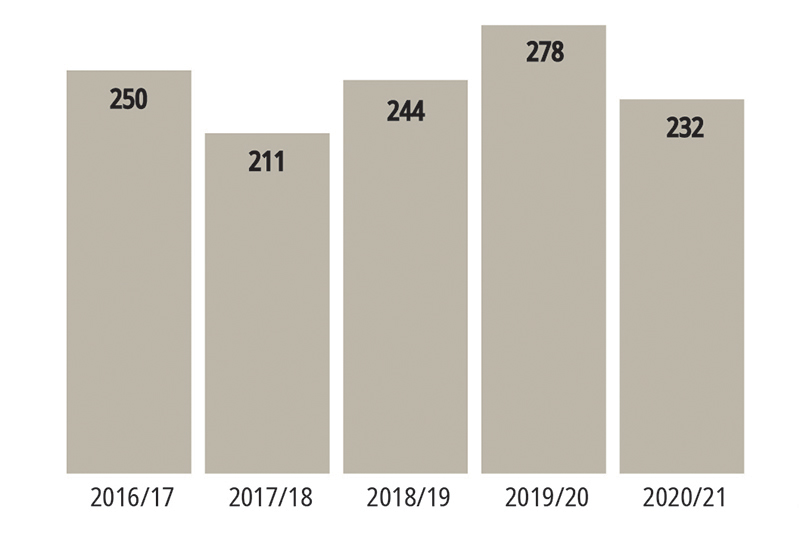
Figure 2-23: Graph breakdown
| 2016/17 | 2017/18 | 2018/19 | 2019/20 | 2020/21 |
|---|---|---|---|---|
| 250 | 211 | 244 | 278 | 232 |
Punishments at Court Martial
In the 2020/21 reporting period, 25 sentences were pronounced by courts martial with a total of 37 punishments. The most common punishments imposed continue to be fines (20), representing approximately 54% of punishments, followed by severe reprimands (5), representing 13% of punishments. A total of three custodial punishments of imprisonment, representing approximately 8% of punishments, were imposed. Figure 2-24 breaks down the punishments imposed by courts martial over the past two reporting periods.
Figure 2-24: Punishments at Courts Martial
| 2019-2020 | 2020-2021 | |
|---|---|---|
| Dismissal* | 1 | 0 |
| Imprisonment | 2** | 3 |
| Detention | 1*** | 0 |
| Reduction in Rank | 3 | 4 |
| Forfeiture of Seniority |
1 | 0 |
| Severe Reprimand | 15 | 5 |
| Reprimand | 6 | 3 |
| Fine | 32 | 20 |
| Confinement to ship or barracks | 0 | 2 |
| Stoppage of leave | 0 | 0 |
| Absolute Discharge |
2 | 0 |
| Total | 63 | 37 |
| * Includes dismissal with disgrace. ** One of these punishments was suspended by the Military Judge. *** This punishment was suspended by the Military Judge. |
||
Sexual Misconduct
During this reporting period, a total of 14 completed courts martial (or approximately 41% of all courts martial) dealt with allegations of sexual misconduct. Of those, nine cases resulted in a finding of guilty on at least one charge; three cases resulted in a stay of proceedings; one case resulted in a termination of proceedings; and one case resulted in all charges being withdrawn by the Director of Military Prosecutions. In the previous reporting period, a total of 25 courts martial (or approximately 45%) dealt with charges of sexual misconduct, with 18 resulting in a finding of guilty. This reporting period saw a decrease of 44% in the number of courts martial dealing with sexual misconduct. Relative to the total number of courts martial held, however, the decrease for the 2020/21 reporting period as compared to the last two reporting periods was approximately 4%, with an increase of approximately 8% in the number of findings of guilty.
Across the 14 cases, 26 charges relating to sexual misconduct were laid. A total of nine charges were laid under section 130 of the National Defence Act alleging sexual assault under section 271 of the Criminal Code; eight charges were laid under section 129 of the National Defence Act, conduct to the prejudice of good order and discipline; four charges were laid under section 93 of the National Defence Act, cruel or disgraceful conduct; three charges were laid under section 97 of the National Defence Act, drunkenness; and one charge was laid under each section 95 of the National Defence Act, abuse of subordinates, and section 279(2) of the Criminal Code, forcible confinement. Figure 2-25 sets out the sexual misconduct cases tried at courts martial during this reporting period, including the pleas and findings on each charge.
Figure 2-25: Cases of Sexual Misconduct at Court Martial
| Case | Neutral Citation | Charges | Plea | Findings |
|---|---|---|---|---|
| R v Bankasingh T. O. (Acting Sub-Lieutenant) | 2021 CM 5009 | Charge 1: S. 130 NDA, sexual assault (s. 271 CCC) | Not guilty | Not guilty |
| Charge 2: S. 93 NDA, behaved in a disgraceful manner | Guilty | Guilty | ||
| R v Bourque D.G. (Major) | 2020 CM 2008 2020 CM 2009 |
Charge 1: S. 129 NDA, conduct to the prejudice of good order and discipline | Guilty | Guilty |
| R v Brown C.A.I. (Lieutenant (Navy)) | 2021 CM 4003 | Charge 1: S. 130 NDA, sexual assault (s. 271 CCC) | N/A | Stay of Proceedings |
| Charge 2: S. 130 NDA, forcible confinement (s. 279(2) CCC) | N/A | Stay of Proceedings | ||
| *Notice of appeal/Leave to appeal (s. 232, National Defence Act). Allowed on February 8, 2022 | ||||
| R v Bruce J.M. (Private) | 2020 CM 5011 | Charge 1: S. 129 NDA, conduct to the prejudice of good order and discipline | Guilty | Guilty |
| R v Chauhan S.R. (Warrant Officer) | 2020 CM 2012 | Charge 1: S. 130 NDA, sexual assault (s. 271 CCC) | N/A | Withdrawn |
| Charge 2: S. 93 NDA, behaved in a disgraceful manner | N/A | Withdrawn | ||
| R v Chiasson M.D. (Petty Officer 2nd Class) | 2020 CM 2006 | Charge 1: S. 97 NDA, drunkenness | Guilty | Guilty |
| R v Christmas K.L. (Corporal) | 2020 CM 3009 | Charge 1: S. 130 NDA, sexual assault (s. 271 CCC) | N/A | *Stay of Proceedings |
| Charge 2: S. 93 NDA, behaved in a disgraceful manner | N/A | *Stay of Proceedings | ||
| Charge 3: S. 97 NDA, drunkenness | N/A | *Stay of Proceedings | ||
| *Retrial Pending (R v Christmas 2022 CMAC 1) | ||||
| R v Cloutier J.R.S. (Sergeant) | 2020 CM 4013 | Charge 1: S. 93 NDA, behaved in a disgraceful manner | N/A | *Stay of Proceedings |
| Charge 2: S. 129 NDA, conduct to the prejudice of good order and discipline | N/A | *Stay of Proceedings | ||
| Charge 3: S. 97 NDA, drunkenness | N/A | *Stay of Proceedings | ||
| *Retrial Pending (R v Proulx; R v. Cloutier 2021 CMAC 3) | ||||
| R v Duquette J.R.E. (Major) | 2019 CM 3016 | Charge 1: S. 130 NDA, sexual assault (s. 271(b) CCC) | Not guilty | Guilty |
| Charge 2: S. 129 NDA, conduct to the prejudice of good order and discipline | Not guilty | Guilty | ||
| Charge 3: S. 95 NDA, ill-treatment of subordinates | Not guilty | Guilty | ||
| R v Iredale M.J. (Captain) | 2020 CM 4008 2020 CM 4009 2020 CM 4011 |
Charges 1, 2, 3: S. 130 NDA, sexual assault (s. 271 CCC) | N/A | *Stay of Proceedings |
| Charges 4, 5, 6: S. 129 NDA, conduct to the prejudice of good order and discipline | N/A | *Stay of Proceedings | ||
| *Retrial Pending (R v Edwards; R v Crepeau; R v Fontaine; R v Iredale 2021 CMAC 2) | ||||
| R v Koutsogiannis P. (Private) | 2020 CM 2010 | Charge 1: S. 129 NDA, conduct to the prejudice of good order and discipline | Guilty | Guilty |
| R v Morissette J.N.S. (Sergeant) | 2020 CM 5008 | Charge 1: S. 129 NDA, conduct to the prejudice of good order and discipline | Guilty | Guilty |
| R v Robertson A.J. (Private) | 2020 CM 5012 | Charge 1: S. 130 NDA, sexual assault (s. 271 CCC) | Not guilty | Not guilty |
| Charge 2: S. 93 NDA, behaved in a disgraceful manner | Guilty | Guilty | ||
| R v Thibault A.J.R. (Sergeant) | 2020 CM 5005 2021 CM 5001 2021 CM 5002 |
Charge 1: S. 130 NDA, sexual assault (s. 271 CCC) | Not guilty | Guilty |

